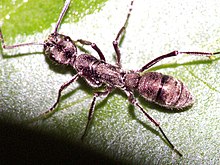| Diacamma rugosum | |
|---|---|

| |
| Scientific classification | |
| Domain: | Eukaryota |
| Kingdom: | Animalia |
| Phylum: | Arthropoda |
| Class: | Insecta |
| Order: | Hymenoptera |
| Family: | Formicidae |
| Genus: | Diacamma |
| Species: | D. rugosum
|
| Binomial name | |
| Diacamma rugosum (Le Guillou, 1842)
| |
| Synonyms | |
| |
Diacamma rugosum, also known as the Bornean queenless ant, is a species of ant of the subfamily Ponerinae. It is found in many countries throughout Southeast Asia. 20 subspecies are recognized.[1]
Diacamma rugosum is noted for being one of the only species of ants to completely lack a queen caste. Reproduction is done entirely by workers, with all workers being fertile upon birth.[2] However, reproduction is kept strictly under control in the nest, with only one dominant female, or gamergate, laying all of the eggs. The gamergate will render workers sterile by mutilating their vestigial wing buds as soon as they pupate.[3] These infertile workers, called callows, will remain loyal to the present gamergate and allow her to exercise control over the rest of the workers.[4] This works to reduce colony infighting as it makes usurpation virtually impossible, and the only time the gamergate is replaced is if she dies naturally.